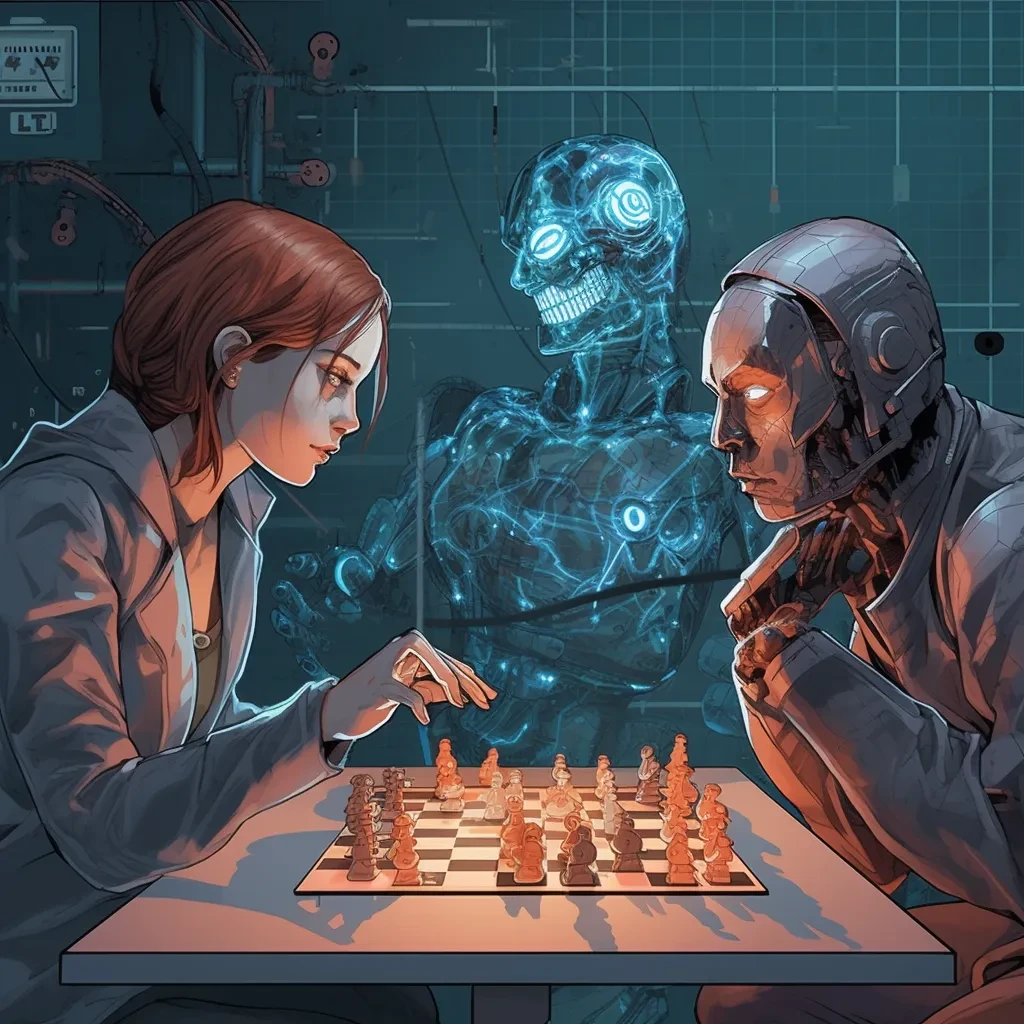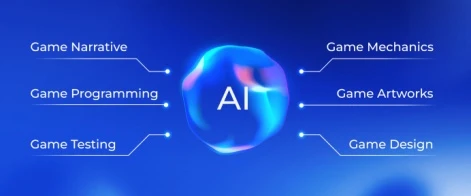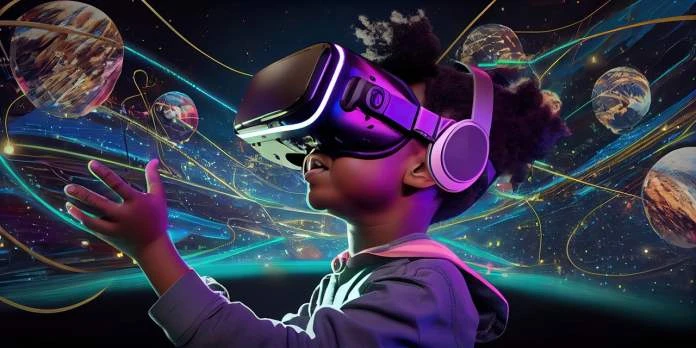The integration of Artificial Intelligence (AI) in game development has revolutionized the gaming industry, offering unprecedented gaming experiences and opening new avenues for innovation. AI's impact is far-reaching, touching various aspects of game design, development, and player engagement. In this blog, we will explore the different types of AI used in gaming, their benefits, and the future prospects of AI in this dynamic field.

1. Non-Player Character (NPC) Behavior: AI algorithms are widely used to control the behavior of NPCs in games. These characters can adapt their actions based on player behavior, leading to more realistic and unpredictable gaming experiences. For example, in stealth games, enemies use AI to detect player actions and respond accordingly.
A classic example of AI-driven NPC behavior in video games, especially in stealth genres, can be seen in the "Metal Gear Solid" series. Here's a detailed example:
In "Metal Gear Solid", the NPCs are enemy soldiers who exhibit sophisticated AI behavior. When the player character, Snake, is sneaking around a base, these soldiers patrol predetermined paths. However, their behavior changes dynamically in response to the player's actions due to AI programming. Here are some key aspects:
a. Alertness to Sound and Sight: If Snake makes a noise, like knocking on a wall or being spotted by a camera, nearby soldiers investigate the source of the disturbance. This demonstrates the AI's ability to respond to auditory and visual stimuli.
b. Communication and Reinforcements: When a soldier spots Snake, he alerts his comrades through a radio call, bringing in reinforcements. This showcases the AI's communication and group response mechanics.
c. Search Patterns: Once alerted, soldiers don't just randomly search for the player. They follow search patterns, like checking hiding spots or moving in groups, indicating a more sophisticated level of AI that mimics tactical search behavior.

These aspects collectively contribute to a more immersive and challenging gameplay experience, where the player must continuously adapt to the evolving strategies of AI-controlled NPCs.
2. Procedural Content Generation:
AI can generate game content procedurally, creating unique environments, levels, and challenges. This not only saves development time but also provides a unique experience for every player. Games like "No Man’s Sky" use AI to generate vast, explorable universes.
Procedural Content Generation (PCG) is a fascinating aspect of AI application in gaming, and "No Man's Sky" by Hello Games is a prime example of this technology. In "No Man's Sky", the game universe is composed of over 18 quintillion planets, each with unique terrain, ecosystems, and wildlife, all generated procedurally by AI algorithms. Here's how it works:
a. Planetary Generation: When a player travels to a new star system and lands on a planet, the game's AI algorithms procedurally generate the planet's landscape, including mountains, oceans, plains, and caves. This is not pre-designed by the developers but created on-the-fly based on algorithmic rules.
b. Flora and Fauna: Each planet comes with its own unique set of flora and fauna. The AI determines the types of plants and animals that inhabit the planet, their appearances, behaviors, and even the ecosystem's food chain.
c. Resource Distribution: The game also uses AI to determine the types of resources available on each planet, influencing what players can mine or harvest. This aspect plays a significant role in the game's survival and crafting systems.

This extensive use of procedural generation means that the game can offer an almost infinite variety of experiences, with players continually discovering new worlds, species, and challenges, all created by AI without the need for detailed input from human designers.
3. Dynamic Game Difficulty Adjustment:
AI can analyze a player’s skill level and adjust the game’s difficulty in real-time. This ensures that the game remains challenging but not frustrating, keeping players engaged for longer periods.
Dynamic Game Difficulty Adjustment (DGDA) is an innovative AI application in video games, aimed at enhancing player engagement by adapting the game's challenge level in real-time based on the player's skill and performance. A notable example of this is the "Resident Evil 4" game developed by Capcom.
In "Resident Evil 4", the game subtly adjusts its difficulty level based on the player's performance, although this feature isn't explicitly advertised. Here's how it works:
a. Enemy Toughness and Behavior: If a player is performing exceptionally well, the game might increase the toughness of the enemies, making them more aggressive or more resilient to damage. Conversely, if a player is struggling, the enemies might become easier, taking more time to attack or being less accurate.
b. Resource Availability: The game also adjusts the availability of resources such as ammunition, health items, and money. Skilled players might find fewer resources, increasing the game's difficulty, while players facing challenges might find more resources to aid them.
c. Boss Fight Difficulty: Even boss fights can be adjusted in terms of the boss's health and attack patterns, tailoring the challenge to the player's demonstrated abilities.

This dynamic adjustment is done seamlessly and without breaking the immersion of the game. The player generally doesn't notice these adjustments; they just experience a game that always feels challenging but not insurmountable. This approach helps keep players engaged, preventing frustration from excessive difficulty while also avoiding boredom from a game that's too easy.
4. AI in Game Testing:
AI tools are used for game testing, identifying bugs and glitches more efficiently than human testers. This speeds up the development process and helps in delivering a more polished final product.
AI in game testing represents a significant advancement in the efficiency and effectiveness of identifying and resolving bugs and glitches during game development. A compelling example of this application can be found in the use of AI by Ubisoft, a leading game developer known for titles like "Assassin's Creed" and "Far Cry".
Ubisoft implemented an AI-based tool named "Commit Assistant" to aid in game testing. Here's how it works and what it accomplishes:
a. Predictive Analysis for Bugs: The AI tool analyzes the game's code to predict where bugs are likely to occur. It uses historical data from previous game development projects to identify patterns and common mistakes that led to bugs in the past.
b. Automated Bug Detection: The AI system can automatically detect potential bugs in the game's code, allowing developers to address these issues before they manifest in the game itself. This proactive approach saves considerable time compared to traditional methods where bugs are often discovered only during or after gameplay testing.
c. Code Review Assistance: The AI tool assists in the code review process. By analyzing new code submissions, it helps identify any inconsistencies or deviations from standard practices that might lead to bugs.
d. Efficiency in Testing: AI-driven testing tools can work continuously, 24/7, testing various parts of a game simultaneously. This level of efficiency is not achievable by human testers alone and significantly speeds up the development cycle.
e. Learning from Mistakes: The AI system continuously learns from new data, meaning it becomes more effective over time at identifying potential bugs and suggesting fixes.

By leveraging AI in this manner, Ubisoft aims to reduce the time and resources spent on bug fixing, allowing them to focus more on creative aspects of game development. This approach not only speeds up the development process but also contributes to a more polished and bug-free final product for the end-users.
5. Voice Recognition and Interaction:
AI-driven voice recognition allows players to interact with the game using natural language, enhancing immersion. Games are increasingly incorporating AI-powered voice assistants that respond to player commands and inquiries.
AI-driven voice recognition and interaction in video games significantly enhance the level of immersion and interactivity, allowing players to engage with the game in more natural and intuitive ways. A prominent example of this technology is seen in the game "Mass Effect 3" from BioWare, especially in its integration with the Kinect sensor for the Xbox 360.
In "Mass Effect 3", players could use voice commands to control various aspects of the game when played on the Xbox 360 with Kinect. Here’s how it added to the gaming experience:
a. Character Commands: Players could issue voice commands to their squadmates during combat. For instance, saying “Liara, Singularity” would prompt the character Liara to use her Singularity ability. This feature allowed for quicker and more fluid combat tactics, as players didn't need to pause the game to select commands manually.
b. Dialogue Selections: The game's immersive dialogue system was further enhanced by allowing players to speak their dialogue choice instead of selecting it with a controller. This feature made conversations feel more natural and engaging.
c. Menu Navigation: Players could also use voice commands for navigating menus and managing inventory. For example, saying "Open Map" or "Inventory" would bring up the respective screen, streamlining the gameplay experience.
d. Environmental Interaction: In some instances, players could interact with the game environment using voice commands, such as opening doors or examining objects.

The integration of voice recognition in "Mass Effect 3" demonstrated how AI could be used to create a more immersive and interactive gaming experience. It allowed players to engage with the game world in a way that was more seamless and intuitive than traditional control schemes. This technology has continued to evolve, with more recent games incorporating even more advanced AI-driven voice interaction capabilities.

Realism:
AI contributes to creating more realistic and immersive game worlds. NPCs with AI-driven behavior provide a more lifelike and dynamic gaming environment.
AI has significantly enhanced realism in video games by creating more lifelike and dynamic environments, especially through the behavior of Non-Player Characters (NPCs). A great example of this is in "The Witcher 3: Wild Hunt" developed by CD Project Red.
a. Dynamic Day-Night Cycles: NPCs in "The Witcher 3" follow a dynamic day-night cycle. For example, during the day, villagers can be seen going about their daily routines, such as working in the fields or opening shops for business. At night, they return to their homes to sleep or gather in taverns. This creates a sense of a living world that operates independently of the player's actions.
b. Reactive Behavior: NPCs react realistically to the environment and the player's actions. If Geralt, the main character, draws his sword in a village, the NPCs respond with fear or aggression. Similarly, if Geralt helps a village by solving their problems, the villagers' attitudes towards him change positively.
c. Contextual Activities: NPCs engage in various activities that are contextually relevant to their environment and situation. For instance, in cities, you might find NPCs engaged in trade, conversations, or recreational activities, while in rural areas, they might be involved in farming or fishing.
d. Weather and Environmental Reactions: The NPCs react to changes in weather and environment. During rain, villagers seek shelter, and during a storm, they express distress. This adds to the realism, as their behavior aligns with natural human reactions.
e. Complex Emotional Responses: The AI in "The Witcher 3" allows NPCs to display a range of emotions based on the situation. For example, they show fear during monster attacks, grief if something tragic happens in their community, or joy during celebrations.

Through these AI-driven behaviors, NPCs in "The Witcher 3" contribute to an immersive and realistic gaming experience, making the game world feel alive and dynamic. This level of detail and realism in NPC behavior is a significant factor in the game's acclaim and popularity.
2. Personalized Gaming Experiences:
AI algorithms can learn from player preferences and behaviors, tailoring the gaming experience to individual players. This personalization increases engagement and player satisfaction.
AI-driven personalization in video games is a growing trend, aiming to enhance player engagement and satisfaction by tailoring the gaming experience to individual preferences and behaviors. A notable example of this approach can be seen in "Dragon Age: Inquisition" by BioWare.
In "Dragon Age: Inquisition", AI algorithms analyze player choices and interactions to personalize the gaming experience in several ways:
a. Narrative and Dialogue Choices: The game features a complex narrative that evolves based on player choices. AI algorithms track these choices to shape future interactions and story developments. For example, decisions made in conversations with NPCs or critical plot decisions can lead to different story outcomes, relationships with characters, and world states.
b. Companion Relationships: AI in the game monitors how players interact with their companions (other characters in the player's party). Based on these interactions, companions may react differently to the player, leading to unique friendship, rivalry, or even romantic storylines.
c. Quest and Encounter Customization: AI algorithms can alter the types and frequencies of quests and encounters based on the player's previous choices and actions. This ensures that the content feels relevant and engaging to the player's unique journey.
d. Learning from Player Behaviors: The AI continuously learns from the player's actions, fine-tuning the game experience to match the player's preferences and playing style. This could mean adjusting the types of enemies encountered, the pacing of the storyline, or the availability of certain resources.

Through these AI-driven personalizations, "Dragon Age: Inquisition" offers a richly individualized experience where the player's choices significantly impact the game world and their experience within it. This level of personalization makes each player's journey through the game unique, enhancing replay value and player engagement.
3. Increased Efficiency in Development:
AI can automate various aspects of game development, from content creation to testing. This not only speeds up the development process but also allows developers to focus on more creative aspects of game design.
AI-driven personalization in video games is a growing trend, aiming to enhance player engagement and satisfaction by tailoring the gaming experience to individual preferences and behaviors. A notable example of this approach can be seen in "Dragon Age: Inquisition" by BioWare
In "Dragon Age: Inquisition", AI algorithms analyze player choices and interactions to personalize the gaming experience in several ways:
a. Narrative and Dialogue Choices: The game features a complex narrative that evolves based on player choices. AI algorithms track these choices to shape future interactions and story developments. For example, decisions made in conversations with NPCs or critical plot decisions can lead to different story outcomes, relationships with characters, and world states.
b. Companion Relationships: AI in the game monitors how players interact with their companions (other characters in the player's party). Based on these interactions, companions may react differently to the player, leading to unique friendship, rivalry, or even romantic storylines.
c. Gameplay Difficulty and Style Adaptation: The game adjusts certain gameplay elements based on the player's performance and choices. For instance, if a player frequently uses stealth tactics, the game might offer more opportunities and challenges that cater to a stealth approach.
d. Quest and Encounter Customization: AI algorithms can alter the types and frequencies of quests and encounters based on the player's previous choices and actions. This ensures that the content feels relevant and engaging to the player's unique journey.
e. Learning from Player Behaviors: The AI continuously learns from the player's actions, fine-tuning the game experience to match the player's preferences and playing style. This could mean adjusting the types of enemies encountered, the pacing of the storyline, or the availability of certain resources.

Through these AI-driven personalizations, "Dragon Age: Inquisition" offers a richly individualized experience where the player's choices significantly impact the game world and their experience within it. This level of personalization makes each player's journey through the game unique, enhancing replay value and player engagement.
4. Improved Game Balance:
AI can continuously analyze game data to identify balance issues, helping developers fine-tune gameplay and mechanics for a better player experience.
AI-driven personalization in video games is a growing trend, aiming to enhance player engagement and satisfaction by tailoring the gaming experience to individual preferences and behaviors. A notable example of this approach can be seen in "Dragon Age: Inquisition" by BioWare.
In "Dragon Age: Inquisition", AI algorithms analyze player choices and interactions to personalize the gaming experience in several ways:
a. Narrative and Dialogue Choices: The game features a complex narrative that evolves based on player choices. AI algorithms track these choices to shape future interactions and story developments. For example, decisions made in conversations with NPCs or critical plot decisions can lead to different story outcomes, relationships with characters, and world states.
b. Companion Relationships: AI in the game monitors how players interact with their companions (other characters in the player's party). Based on these interactions, companions may react differently to the player, leading to unique friendship, rivalry, or even romantic storylines.
c. Gameplay Difficulty and Style Adaptation: The game adjusts certain gameplay elements based on the player's performance and choices. For instance, if a player frequently uses stealth tactics, the game might offer more opportunities and challenges that cater to a stealth approach.
d. Quest and Encounter Customization: AI algorithms can alter the types and frequencies of quests and encounters based on the player's previous choices and actions. This ensures that the content feels relevant and engaging to the player's unique journey.
Through these AI-driven personalizations, "Dragon Age: Inquisition" offers a richly individualized experience where the player's choices significantly impact the game world and their experience within it. This level of personalization makes each player's journey through the game unique, enhancing replay value and player engagement.

Through these AI-driven personalizations, "Dragon Age: Inquisition" offers a richly individualized experience where the player's choices significantly impact the game world and their experience within it. This level of personalization makes each player's journey through the game unique, enhancing replay value and player engagement.

The future of AI in gaming is incredibly promising. We are likely to see:
1. Advanced AI Characters: Future games might feature AI-driven characters with advanced learning capabilities, capable of evolving and adapting in complex ways.
2. Interactive Storytelling: AI could be used to craft dynamic narratives that change based on player decisions, leading to highly personalized storytelling.
3. Virtual Reality and AI Integration: The combination of VR and AI could lead to fully immersive environments where AI not only controls the narrative and characters but also the entire game world.
4. AI in Esports and Competitive Gaming: AI might be used to provide real-time coaching and strategy optimization in competitive gaming scenarios.
5. Ethical and Creative AI Use: As AI becomes more integral to game development, ethical considerations about its use will also grow. Developers will need to balance AI-driven innovation with responsible design.
AI's role in game development is transformative and continuously evolving. Its integration offers numerous benefits, enhancing both the gaming experience for players and the development process for creators. As technology advances, AI will undoubtedly continue to shape the landscape of game design and player interaction, heralding a new era of immersive, intelligent, and personalized gaming.


